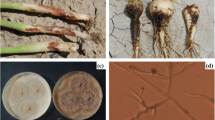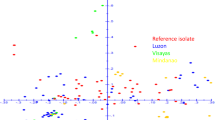Abstract
Soil-borne Rhizoctonia fungi cause serious diseases in several plant species. For the classification of these fungi, the number of nuclei in a hyphal cell and the anastomosis reaction are important criteria. Although Rhizoctonia spp. has a wide host range, the causal agents have been reported to be selective for host plant families or species and lead to severe disease. Reports of new diseases, particularly in new host plants, and severe damage in agricultural fields incurred by subdivided or newly found groups of Ceratobasidium and Waitea circinata (a varied teleomorph of Rhizoctonia) have been increasing in recent years. The food production environment is altering because of climate change, introduction of potential new host plants, and heavy use of chemicals that reduce microbial diversity. These changes favor the occurrence of new diseases incurred by undefined anastomosis groups (AGs) or subgroups of Rhizoctonia spp. On the basis of the phylogenetic relationships of AGs and subgroups in Rhizoctonia spp., molecular markers for discriminating the groups of the Rhizoctonia species complex have been developed. The application of genetic markers, in the form of microsatellites or simple sequence repeats (SSR), has become increasingly important in fungal genetics. The analyses of population genetics for Rhizoctonia spp. using SSR markers elucidated the modes of sexual and asexual reproduction, phylogeographical distributions, and global migrations associated with adaptation to agroecosystems.
Similar content being viewed by others
References
Ahvenniemi P, Wolf M, Lehtonen MJ, Wilson P, German-Kinnari M, Valkonen JPT (2009) Evolutionary diversification indicated by compensatory base changes in ITS2 secondary structures in a complex fungal species, Rhizoctonia solani. J Mol Evol 69:150–163
Anderson NA (1982) The genetics and pathology of Rhizoctonia solani. Annu Rev Phytopathol 20:329–347
Bernardes de Assis J, Peyer P, Rush MC, Zala M, McDonald BA, Ceresini PC (2008) Divergence between sympatric rice- and soybean-infecting populations of Rhizoctonia solani anastomosis group-1 IA. Phytopathology 98:1326–1333
Bernardes-de-Assis J, Storari M, Zala M, Wang W, Jiang D, ShiDong L, Jin M, McDonald BA, Ceresini PC (2009) Genetic structure of populations of the rice-infecting pathogen Rhizoctonia solani AG-1 IA from China. Phytopathology 99:1090–1099
Boysen M, Borja M, del Moral C, Salazar O, Rubio V (1996) Identification at strain level of Rhizoctonia solani AG4 isolates by direct sequence of asymmetric PCR products of the ITS regions. Curr Genet 29:174–181
Carling DE, Kuninaga S, Brainard KA (2002) Hyphal anastomosis reactions, rDNA-internal transcribed spacer sequences, and virulence levels among subsets of Rhizoctonia solani anastomosis group-2 (AG-2) and AG-BI. Phytopathology 92:43–50
Ceresini PC, Shew HD, James TY, Vilgalys RJ, Cubeta MA (2007) Phylogeography of the Solanaceae-infecting Basidiomycota fungus Rhizoctonia solani AG-3 based on sequence analysis of two nuclear DNA loci. BMC Evol Biol 7:163
Chaijuckam P, Baek JM, Greer CA, Webster RK, Davis RM (2010) Population structure of Rhizoctonia oryzae–sativae in California rice fields. Phytopathology 100:502–510
Chen C-M, de la Cerda KA, Kaminski JE, Douhan GW, Wong FP (2009) Geographic distribution and rDNA-ITS region sequence diversity of Waitea circinata var. circinata isolated from annual bluegrass in the US. Plant Dis 93:906–911
Chen C-M, Douhan GW, Wong FP (2011) First report of basal leaf blight of kikuyugrass caused by Waitea circinata var. prodigus in Southern California. Plant Dis 95:767
Ciampi MB, Meyer MC, Costa MJ, Zala M, McDonald BA, Ceresini PC (2008) Genetic structure of populations of Rhizoctonia solani anastomosis group-1 IA from soybean in Brazil. Phytopathology 98:932–941
Cubeta MA, Vilgalys R (1997) Population biology of the Rhizoctonia solani complex. Phytopathology 87:480–484
Dmitriev DA, Rakitov RA (2008) Decoding of superimposed traces produced by direct sequencing of heterozygous indels. PLoS Comput Biol 4:e1000113
Ferrucho RL, Zala M, Zhang Z, Cubeta MA, Garcia-Dominguez C, Ceresini PC (2009) Highly polymorphic in silico-derived microsatellite loci in the potato-infecting fungal pathogen Rhizoctonia solani anastomosis group 3 from the Colombian Andes. Mol Ecol Res 9:1013–1016
Ferrucho RL, Ceresini PC, Ramirez-Escobar UM, McDonald BA, Cubeta MA, García-Domínguez C (2013) The population genetic structure of Rhizoctonia solani AG-3PT from potato in the Colombian Andes. Phytopathology 103:862–869
Gardes M, Bruns TD (1993) ITS primers with enhanced specificity for basidiomycetes––application to the identification of mycorrhizae and rusts. Mol Ecol 2:113–118
Godoy-Lutz G, Kuninaga S, Steadman JR, Powers K (2008) Phylogenetic analysis of Rhizoctonia solani subgroups associated with web blight symptoms on common bean based on ITS-5.8S rDNA. J Gen Plant Pathol 74:32–40
González García V, Portal Onco MA, Rubio Susan V (2006) Biology and systematics of the form genus Rhizoctonia. Span J Agric Res 4:55–79
González-Vera AD, Bernardes-de-Assis J, Zala M, McDonald BA, Correa-Victoria F, Graterol-Matute EJ, Ceresini PC (2010) Divergence between sympatric rice- and maize-infecting populations of Rhizoctonia solani AG-1 IA from Latin America. Phytopathology 100:172–182
Guo Q, Ogasawara T, Arakawa M, Inagaki K (2003) Annual changes in the number of vegetative compatibility groups of rice sheath blight fungus, Rhizoctonia solani AG-1 (IA), in a paddy field (in Japanese with English summary). Jpn J Phytopathol 69:212–219
Guo Q, Kamio A, Sharma BS, Sagara Y, Arakawa M, Inagaki K (2006) Survival and subsequent dispersal of rice sclerotial disease fungi, Rhizoctonia oryzae and Rhizoctonia oryzae–sativae, in paddy fields. Plant Dis 90:615–622
Hayakawa T, Toda T, Ping Q, Mghalu JM, Yaguchi S, Hyakumachi M (2006) A new subgroup of Rhizoctonia AG-D, AG-D III, obtained from Japanese zoysia grass exhibiting symptoms of a new disease. Plant Dis 90:1389–1394
Hietala AM, Vahala J, Hantula J (2001) Molecular evidence suggests that Ceratobasidium bicorne has an anamorph known as a conifer pathogen. Mycol Res 105:555–562
Hyakumachi M, Priyatmojo A, Kubota M, Fukui H (2005) New anastomosis groups, AG-T and AG-U, of binucleate Rhizoctonia spp. causing root and stem rot of cut-flower and miniature roses. Phytopathology 95:784–792
Inagaki K (1998) Dispersal of rice sheath blight fungus, Rhizoctonia solani AG-1 (IA), and subsequent disease development in paddy fields, from survey of vegetative compatibility groups. Mycoscience 39:391–397
Inagaki K, Guo Q, Arakawa M (2004) Overwintering of rice sclerotial disease fungi, Rhizoctonia and Sclerotium spp. in paddy fields in Japan. Plant Pathol J 3:81–87
Johanson A, Turner HC, McKay GJ, Brown AE (1998) A PCR-based method to distinguish fungi of the rice sheath-blight complex, Rhizoctonia solani, R. oryzae and R. oryzae–sativae. FEMS Microbiol Lett 162:289–294
Justesen AF, Yohalem D, Bay A, Nicolaisen M (2003) Genetic diversity in potato field populations of Thanatephorus cucumeris AG-3, revealed by ITS polymorphism and RAPD markers. Mycol Res 107:1323–1331
Kammerer SJ, Burpee LL, Harmon PF (2011) Identification of a new Waitea circinata variety causing basal leaf blight of seashore paspalum. Plant Dis 95:515–522
Kuninaga S (2002) Current situation of the taxonomy of the genus Rhizoctonia and the R. solani species complex (in Japanese with English summary). Jpn J Phytopathol 68:3–20
Kuninaga S (2003) Current situation of the taxonomy of Rhizoctonia solani (in Japanese). Plant Protect 57:219–222
Kuninaga S, Carling DE, Takeuchi T, Yokosawa R (2000) Comparison of rDNA-ITS sequences between potato and tobacco strains in Rhizoctonia solani AG-3. J Gen Plant Pathol 66:2–11
Lees AK, Cullen DW, Sullivan L, Nicolson MJ (2002) Development of conventional and quantitative real-time PCR assays for the detection and identification of Rhizoctonia solani AG-3 in potato and soil. Plant Pathol 51:293–302
Lim S, Notley-McRobb L, Lim M, Carter DA (2004) A comparison of the nature and abundance of microsatellites in 14 fungal genomes. Fungal Genet Biol 41:1025–1036
MacNish GC, Carling DE, Brainard KA (1993) Characterization of Rhizoctonia solani AG-8 from bare patches by pectic isozyme (zymogram) and anastomosis techniques. Phytopathology 83:922–927
Matsumoto M (2002) Trials of direct detection and identification of Rhizoctonia solani AG 1 and AG 2 subgroups using specifically primed PCR analysis. Mycoscience 43:185–189
McDonald BA (1997) The population genetics of fungi: tools and techniques. Phytopathology 87:448–453
Naito S, Sugimoto T (1978) Basidio-spore infection and lesion development on sugar beet leaves by Thanatephorus cucumeris (Frank) Donk. Ann Phytopath Soc Japan 44:426–431
Naito S, Mochida H, Nakajima T, Ohto Y (1995) Infection with basidiospores of Thanatephorus cucumeris (AG 2-3 of Rhizoctonia solani) and development of soybean foliar blight lesions. Ann Phytopathol Soc Jpn 61:362–368
Ogoshi A (1987) Ecology and pathogenicity of anastomosis and intraspecific groups of Rhizoctonia solani Kühn. Annu Rev Phytopathol 25:125–143
Ogoshi A, Ui T (1983) Diversity of clones within an anastomosis group of Rhizoctonia solani Kühn in a field (in Japanese with English summary). Ann Phytopath Soc Japan 49:239–245
Okubara PA, Schroeder KL, Paulitz TC (2008) Identification and quantification of Rhizoctonia solani and R. oryzae using real-time polymerase chain reaction. Phytopathology 98:837–847
Pannecoucque J, Höfte M (2009) Detection of rDNA ITS polymorphism in Rhizoctonia solani AG 2-1 isolates. Mycologia 101:26–33
Priyatmojo A, Escopalao VE, Tangonan NG, Pascual CB, Suga H, Kageyama K, Hyakumachi M (2001) Characterization of a new subgroup of Rhizoctonia solani anastomosis group 1 (AG-1-ID), causal agent of a necrotic leaf spot on coffee. Phytopathology 91:1054–1061
Sayler RJ, Yang Y (2007) Detection and quantification of Rhizoctonia solani AG-1 IA, the rice sheath blight pathogen, in rice using real-time PCR. Plant Dis 91:1663–1668
Sharon M, Kuninaga S, Hyakumachi M, Sneh B (2006) The advancing identification and classification of Rhizoctonia spp. using molecular and biotechnological methods compared with the classical anastomosis grouping. Mycoscience 47:299–316
Sharon M, Kuninaga S, Hyakumachi M, Naito S, Sneh B (2008) Classification of Rhizoctonia spp. using rDNA-ITS sequence analysis supports the genetic basis of the classical anastomosis grouping. Mycoscience 49:93–114
Stalpers JA, Andersen TF (1996) A synopsis of the taxonomy of teleomorphs connected with Rhizoctonia SL. In: Sneh B, Jabaji-Hare S, Neate S, Dijst G (eds) Rhizoctonia species: taxonomy, molecular biology, ecology, pathology and disease control. Kluwer, Dordrecht, pp 49–63
Stukenbrock EH, McDonald BA (2008) The origins of plant pathogens in agro-ecosystems. Annu Rev Phytopathol 46:75–100
Toda T, Mghalu JM, Hayakawa T, Hyakumachi M (2004) Development of specific primers for each variety of Rhizoctonia circinata (abstract). Inoculum 55(4):36–37
Zala M, McDonald BA, Bernardes de Assis J, Ciampi MB, Storari M, Peyer P, Ceresini PC (2008) Highly polymorphic microsatellite loci in the rice-and maize-infecting fungal pathogen Rhizoctonia solani anastomosis group 1 IA. Mol Ecol Res 8:686–689
Zheng A, Lin R, Zhang D, Qin P, Xu L, Ai P, Ding L, Wang Y, Chen Y, Liu Y, Sun Z, Feng H, Liang X, Fu R, Tang C, Li Q, Zhang J, Xie Z, Deng Q, Li S, Wang S, Zhu J, Wang L, Liu H, Li P (2013) The evolution and pathogenic mechanisms of the rice sheath blight pathogen. Nat Commun 4:1424
Acknowledgments
The authors thank Dr. Bruce A. McDonald, ETH Zürich, and Dr. Paulo C. Ceresini, UNESP, for critical review of the manuscript and helpful comments. This work was supported in part by a Grant-in-Aid for Young Scientists (B) No. 16780032 from the Japan Society for the Promotion of Science.
Author information
Authors and Affiliations
Corresponding author
Rights and permissions
About this article
Cite this article
Arakawa, M., Inagaki, K. Molecular markers for genotyping anastomosis groups and understanding the population biology of Rhizoctonia species. J Gen Plant Pathol 80, 401–407 (2014). https://doi.org/10.1007/s10327-014-0536-0
Received:
Accepted:
Published:
Issue Date:
DOI: https://doi.org/10.1007/s10327-014-0536-0




